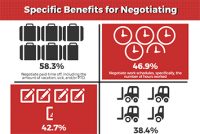Employee feedback, compliance, government forms, leave policies, recruiting: the list of tasks that an HR professional have to perform is nearly endless. Just as important as any one task is how professionals put them all together into a united front. Welcome to the Strategic HR topic.
Recruiting is one of the hottest issues for HR professionals largely thanks to an improving economy and low unemployment rates. So our HR Daily Advisor research team decided to conduct a survey on the recruiting landscape for 2017. Among other practices, we wondered how employers were approaching their conversations with job candidates in the areas […]
Wellness programs sound like a great idea to improve employees’ health status, minimize absenteeism, and generally improve your workplace. Yesterday we looked at some simple ways to introduce wellness programs at your office. However, it’s not all sun salutations and stress breaks. Here are some basic pitfalls that sometimes make a wellness program a little […]
Yesterday’s Advisor made the case for customer service training by describing how one company experienced great growth by focusing on customer service. Today we take a look at training employees to give their coworkers great service.
Almost every organization—regardless of industry—shares a similar greatest asset: their workforce. In fact, for many organizations their human capital is what differentiates them from their competition. The right talent will constantly hit the points your organization is striving for—whether through having meaningful and productive conversations with clients, making good decisions that benefit the organization, or contributing to an overall positive work environment.
Chronic illnesses, such as diabetes and heart disease, can be devastating for your employees, seriously jeopardizing their health and well-being. Additionally, they can take a toll on your business, resulting in high absenteeism and increased healthcare costs.
In today’s Advisor we’ll see how one company made customer service a priority—in part through service education and training—and experienced a great increase in sales as a result.
There are many challenges that all managers face. Whilst these challenges can arise at any point in a manager’s career, they can be particularly prevalent for newer or first-time managers. We’ve compiled a handy list of these challenges with tips on how to combat them, become the best manager possible, and support your team on its way to success.
When employers have a sense of how their peers’ benefits and compensation approaches measure up to their own, they can more confidently identify opportunities for improvement. The Best-in-Class Benchmarking Analysis produced by Arthur J. Gallagher & Co. (Gallagher) examines the strategies and tactics used by high-performing organizations to control healthcare cost spending while competing for […]
Employee burnout. Everyone’s heard of it and most of us have probably complained about feeling burnt out at one point or another. How can we not? For many, the pressure to succeed at work has never been higher. This is true for both hourly and salaried employees, as the opportunity to unplug has become increasingly rare.
Once news of an impending reorganization hits a company, the environment of that company changes almost immediately. However, there are steps that leaders within the organization can take—before, during, and immediately following a reorganization—that can salvage the culture of the company and help those that remain to feel secure and invested in the company.










